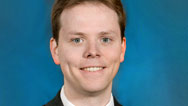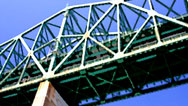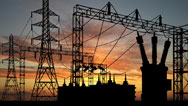Smart Bridges
- Posted 07.16.08
- NOVA scienceNOW
(This program is no longer available for online streaming.) After the Minneapolis Interstate 35 bridge collapsed in 2007, millions became nervous about crossing long highway spans. What can be done to avert the next catastrophe? One technique probes bridge supports with ultrasonic sound waves, searching for "sour notes" that signal damaged metal, while another uses nanotechnology to create a coating that detects structural damage beneath its surface.
Transcript
SMART BRIDGES
PBS Airdate: July 16, 2008
NEIL DeGRASSE TYSON: As we travel around by car, we expect the bridges we have to cross to be safe and secure. But many of them are very old, and a few have already collapsed. Wouldn't it be great if engineers could create a technology so that bridges could tell us what's wrong and how to fix it, before it's too late?
Correspondent Peter Standring reports on efforts to prevent another tragedy like the one that happened in Minneapolis not long ago.
911 OPERATOR (female): Minneapolis 911.
911 CALLER (female): The bridge collapsed! People are stacked up on 35! The whole bridge fell into the river!
PETER STANDRING (Correspondent): At the end of rush hour, on a hot summer day, in Minneapolis, Minnesota, a major bridge over the Mississippi River suddenly collapsed.
911 CALLER (male): I think there are people trapped in cars is what I'm really worried about.
911 CALLER (female):...in the river, there are cars sinking and people in their cars.
911 OPERATOR (male): We know, ma'am. Everyone's on the way.
PETER STANDRING: Over 100 cars fell with the bridge, among them, a community center school bus carrying 54 children.
SASHA BOUYE (Waite House Neighborhood Center): ...and then, all of a sudden out of nowhere, it was just this big drop.
JULIE GRAVES (Waite House Neighborhood Center): It all...hit our heads, come back down, hit our heads, come back down. You just heard kids screaming.
SASHA BOUYE: Oh my god, oh my god! What happened, what happened?
PETER STANDRING: The disaster killed 13 people and seriously injured over 100 more. And if this bridge collapsed, what about all the others like it across the country?
JIM OBERSTAR (D-Minnesota, U.S. House of Representatives): We have 76,000 structurally-deficient bridges in the United States. That's almost two and a half times as many as we had 20 years ago. And we need more modern non-destructive technologies to inspect those bridges today, to make them safer for the future.
PETER STANDRING: The cause of the Minneapolis collapse is still under a federal investigation, but here's what we know: the Minneapolis bridge was an under-deck truss-arch design made up of twin trusses of steel beams arranged in triangles and connected with steel plates, called gussets. The trusses distribute the weight of the traffic throughout the structure, all the parts working together. But the design has no backup against failure. If one major part fails, the whole bridge can come crashing down.
Investigators found that 16 of those connecting gusset plates failed, resulting in the catastrophic collapse.
The tragedy was seen as a wake-up call, highlighting the need for technology that warns us before a bridge fails, technology appearing on bridges, even today.
About an hour's drive east of Minneapolis, along Interstate 94, you'll find this bridge, spanning the Red Cedar River, in Wisconsin. It has an under-deck truss-arch design that's almost identical to the bridge that collapsed.
In fact, this one is 10 years older. So down below, on its aging steel structure, crews from the Wisconsin department of transportation are installing sensors to give it a kind of high tech physical.
This will keep me in the basket?
FINN HUBBARD (Bridge Engineer): This will keep you attached to the basket.
PETER STANDRING: I'm not crazy about heights, but the only way to see for myself was to climb into the basket, as bridge engineer Finn Hubbard took me up, over the edge and under the bridge.
FINN HUBBARD: We're coming back now, and taking a look at it with our sensors, today, to find out how the bridge is doing inside, if you will, looking at the stress and the strain, the forces inside the members themselves.
PETER STANDRING: The sensors, called strain gauges, are welded onto critical spots on the bridge.
FINN HUBBARD: What that does is it actually measures the strain, which is that actual stretching of the metal, sort of like stretching a rubber band.
PETER STANDRING: The gauge is attached to the bridge, so that when the steel stretches, the gauge stretches, changing its electrical resistance. By comparing the gauges' readings to the way the bridge is supposed to perform, Finn can tell if the metal is overly stressed.
Do you think that, ultimately, this is making for a safer bridge, or at least is going to give you the information that you need to keep it safe?
FINN HUBBARD: I think what it's going to do is give us that added measure of insurance that the bridge is behaving the way the computer model back in the office is saying it is.
PETER STANDRING: But strain gauges have serious limitations. They can only give you one type of information at one spot on the bridge. And they can't warn you of an imminent collapse.
If we could only probe deep inside an old bridge's inner structure to find out which are in danger and which are sound...Well, turns out we can, the same way that submarines detect other boats, using the echoes of sound waves, or sonar.
At the University of California, San Diego, they're using a kind of sonar technology to find cracks in bridges. They're called piezoelectric sensors, and they can both send and receive high frequency tones right through a bridge.
ERIC FLYNN (Structural Engineer): So this one will launch a wave into the structure, while this white one, here, will then detect the signal at the other end.
PETER STANDRING: The wave is ultrasonic, so Eric's computer converts the signal so that we can hear it.
ERIC FLYNN: All right. So what we have here is our signal that we received on the healthy structure plate. And if we downshift that ultrasonic signal into the audible range, this is what we hear...very nice clear tone.
PETER STANDRING: But if you fracture that steel plate, the crack forces the ultrasonic waves to take different paths.
ERIC FLYNN: Now we replace that healthy beam with a damaged beam. Put the same sensors on it and apply the same signal again. This is what we get out. You can both see the difference and hear the difference: these extra tones that are now present in that damaged plate.
PETER STANDRING: So how would that work on a bridge? You can place a bunch of these devices around trouble spots like gusset plates, and then have them ping each other in different combinations, probing for problems, such as cracks in the structure.
MICHAEL TODD (Structural Engineer): What we do is we deploy arrays of these, many of these, on a structure, and then we launch waves, and we listen. And the idea then becomes, if you keep doing that test, and a crack has developed, maybe corrosion has occurred, a bolt is coming loose, or...the signature that we're detecting is going to fundamentally change.
PETER STANDRING: But the ideal technology would not only probe for damage and signal its location, it would literally show you where it's broken.
At the University of Michigan, researchers have developed a nanotech skin that could one day cover and monitor bridge, 24/7. Here they've successfully tested a coating that, when stimulated with an electric current, senses damage beneath its surface. And the secret of the sensing skin is the new wonder material of nanotechnology, carbon nanotubes.
Carbon nanotubes are microscopic tubes of carbon atoms that join up under extreme temperatures. Many times stronger and lighter than steel, carbon nanotubes are also amazing conductors of electricity, and it's the electrical properties of these tiny tubes that make the sensing skin possible.
JEROME LYNCH (University of Michigan): The honor is all yours, Peter.
PETER STANDRING: Breaking the skin, here we go.
JEROME LYNCH: Excellent.
PETER STANDRING: To test the system, Professor Jerry Lynch let me punch holes through a steel plate covered with nanotech skin.
JEROME LYNCH: So, with your incredible strength, you can see that you punctured all the way through the plate.
PETER STANDRING: The electricity passing through the skin creates a high resolution map on a computer, providing a visual representation of the puncture holes.
JEROME LYNCH: So the magnitude of damage would be correlated to the color-coding that we have here on our images.
PETER STANDRING: The skin could be sprayed or glued over critical bridge components. When damage starts to form, the skin's electrical current is forced to flow in different directions, change that a computer reads and displays as damage. And by altering the chemistry, different layers of the skin can be made to detect different types of damage—deformation, cracks, corrosion—all at the same time, catching threats before they become dangerous.
Could you envision, you know, a bridge engineer, sitting in his office, monitoring the wellbeing of a structure through a system like this?
JEROME LYNCH: Yes, that's one of the beauties of this particular technology...is how self-evident damage appears in these images.
PETER STANDRING: Within months of the Minneapolis collapse, construction on a replacement bridge is already underway.
LINDA FIGG (FIGG Bridge Engineers): This bridge is a big responsibility for restoring confidence. We expect our bridges to be safe and to get us where we need to be every day.
PETER STANDRING: The new bridge is being built of high density concrete, and its design includes multiple backups against failure and what is promised to be a state-of-the-art sensor system.
LINDA FIGG: The main concept is to have many different technologies working in concert. And, collectively, these will all work together to bring us the best data for the bridge.
PETER STANDRING: But even as the bridge takes shape, the scene evokes mixed feelings for Julie and Sasha.
SASHA BOUYE: I think this might be the only bridge that I may feel comfortable going across, because it is a new structure.
JULIE GRAVES: The new bridge, no matter how many times I cross it, for me, I'll just...I'm never going to get the sounds and the sight out of my head from the actual bridge collapse.
Credits
Smart Bridges
- Edited by
- Ezra Gold & Robert Hutchings
- Produced and Directed by
- Kristian Berg
NOVA scienceNOW
- Executive Producer
- Samuel Fine
- Executive Editor
- Neil deGrasse Tyson
- Senior Series Producer
- Vincent Liota
- Supervising Producers
- Stephen Sweigart
Joey David - Editorial Producer
- Julia Cort
- Development Producer
- Vinita Mehta
- Senior Editor
- David Chmura
- Online Editor
- Laura Raimondo
- Series Production Assistant
- Fran Laks
- Assistant Editors
-
Susan Perla
Tung-Jen (Sunny) Chiang - Compositors
- Brian Edgerton
Yunsik Noh - Music
- Rob Morsberger
- NOVA scienceNOW series animation
- Edgeworx
- Associate Producers
- Cully Gallagher
John Goebel
Daniel Sites
Anna Lee Strachan - Camera
-
John Chater
Austin de Besche
Brian Dowley
Joseph Friedman
Michael Phillips - Sound Recordists
- Ray Day
Lee Frank
Lisa Johnson
Charlie Macarone
Myron Partman - Sound Mix
- David Chmura
- Animation
- FIGG Bridge Engineers, Inc.
Anthony Kraus
David Margolies
Sputnik Animation
James LaPlante
Adam Tow - Production Assistants
- Mona Damluji
Nadira Ilana
Drew Grimes
Elizabeth Stachow - For Lone Wolf Documentary Group
- Executive Producer
- Kirk Wolfinger
- Production Manager
- Donna Huttemann
- For Twin Cities Public Television
- Executive Producer
- Richard Hudson
- Managing producer
- Lynn Winter
- Archival Material
- Federal Emergency Management Agency
Getty
Internet Moving Images Archive
ITN
Ville Karvinen
Knoxville Zoo
Jan Karel Lameer
The Macaulay Library at the Cornell Lab of Ornithology
NASA
Penn State University Archives, Pennsylvania State University Libraries
Luc de Nil
WCCO-TV - Special Thanks
- Simon Baker
Aleksander Chernucho
Dennis Kavlakoglu
Libby Lewis Photography
The Methodist Neurological Institute
Museum of Science and Industry
New York Presbyterian Hospital, the University Hospital of Columbia and Cornell and Citigroup Biomedical Imaging Center
Ian Ryan
Phil Schneider
Sahar Salem
Veronica Smith
Francois Thibaut and The Language Workshop for Children
Waite House - Neil deGrasse Tyson
- is director of the Hayden Planetarium in the Rose Center for Earth and Space at the American Museum of Natural History.
- NOVA scienceNOW Consortium Stations
- Nebraska Educational Telecommunications, NET
Public Broadcasting for Northern California, KQED
Twin Cities Public Television, TPT
Wisconsin Public Television, WPT - NOVA Series Graphics
- yU + co.
- NOVA Theme Music
- Walter Werzowa
John Luker
Musikvergnuegen, Inc. - Additional NOVA Theme Music
- Ray Loring
Rob Morsberger - Post Production Online Editor
- Spencer Gentry
- Closed Captioning
- The Caption Center
- Publicity
- Carole McFall
Eileen Campion
Lindsay de la Rigaudiere
Victoria Louie
Kate Becker - Senior researcher
- Gaia Remerowski
- Production Coordinator
- Linda Callahan
- Paralegals
- Raphael Nemes
Sarah Erlandson - Talent Relations
- Scott Kardel, Esq.
Janice Flood - Legal Counsel
- Susan Rosen
- Post Production Assistant
- Darcy Forlenza
- Associate Producer, Post Production
- Patrick Carey
- Post Production Supervisor
- Regina O'Toole
- Post Production Editors
- Rebecca Nieto
Alex Kreuter - Post Production Manager
- Nathan Gunner
- Compliance Manager
- Linzy Emery
- Business Manager
- Joseph P. Tracy
- Producers, Special Projects
- Lisa Mirowitz
David Condon - Coordinating Producer
- Laurie Cahalane
- Senior Science Editor
- Evan Hadingham
- Senior Series Producer
- Melanie Wallace
- Managing Director
- Alan Ritsko
- Senior Executive Producer
- Paula S. Apsell
This material is based upon work supported by the National Science Foundation under Grant No. 0638931. Any opinions, findings, and conclusions or recommendations expressed in this material are those of the author(s) and do not necessarily reflect the views of the National Science Foundation.
NOVA scienceNOW is a trademark of the WGBH Educational Foundation
NOVA scienceNOW is produced for WGBH/Boston by NOVA
© 2008 WGBH Educational Foundation
All rights reserved
- Image credit: (bridge) photo by Kristian Berg/© WGBH Educational Foundation
Participants
- Sasha Bouye
- Waite House Neighborhood Center
- Linda Figg
- FIGG Bridge Engineers
- Eric Flynn
- Structural Engineer
- Julie Graves
- Waite House Neighborhood Center
- Finn Hubbard
- Bridge Engineer
- Jerome Lynch
- University of Michigan www-personal.umich.edu/~jerlynch/proflynch.html
- Jim Oberstar
- United States House of Representatives www.oberstar.house.gov/
- Peter Standring
- Correspondent
- Michael Todd
- Structural Engineer structures.ucsd.edu/index.php?page=structural_engineering/people/faculty/todd
Related Links
-

Smart Bridges: Expert Q&A
The University of Michigan's Jerome Lynch answers questions about the future for "smart" bridges, and more.
-

Bridge Doctors
In this audio interview, structural engineer Michael Todd describes the state of bridge monitoring around the world.
-

Why the Bridges Failed
Find out what caused eight infamous bridge collapses.
-

Smart Grid
Our electric grid is a marvel of 20th-century engineering, but it's showing signs of strain. Can a "smart grid" help?



